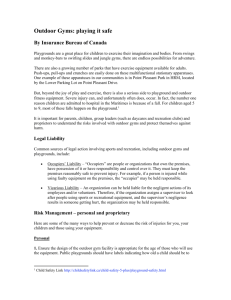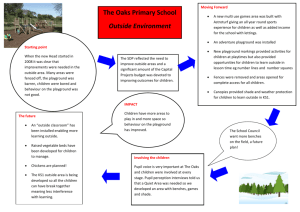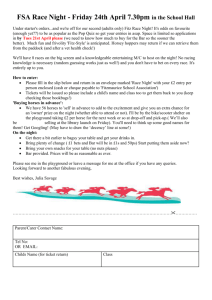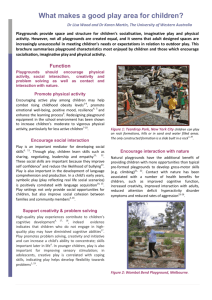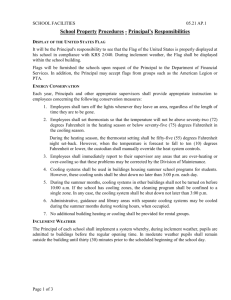WASSONG, STEPHAN. Playgrounds und Spielplätze. Die
advertisement
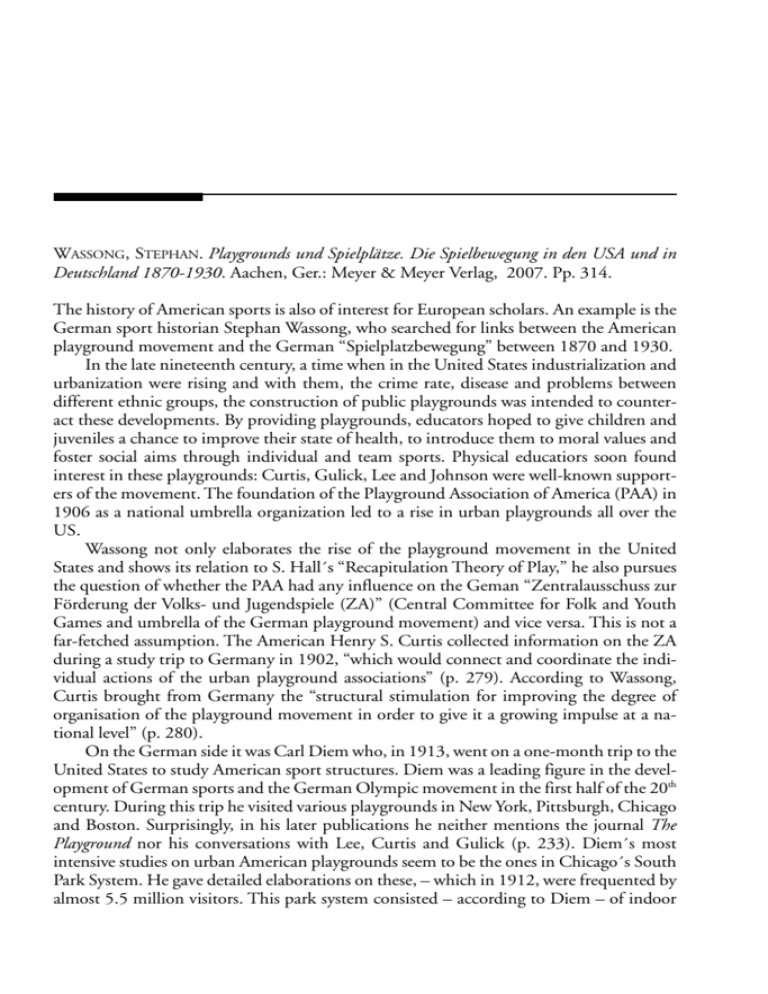
WASSONG, STEPHAN. Playgrounds und Spielplätze. Die Spielbewegung in den USA und in Deutschland 1870-1930. Aachen, Ger.: Meyer & Meyer Verlag, 2007. Pp. 314. The history of American sports is also of interest for European scholars. An example is the German sport historian Stephan Wassong, who searched for links between the American playground movement and the German “Spielplatzbewegung” between 1870 and 1930. In the late nineteenth century, a time when in the United States industrialization and urbanization were rising and with them, the crime rate, disease and problems between different ethnic groups, the construction of public playgrounds was intended to counteract these developments. By providing playgrounds, educators hoped to give children and juveniles a chance to improve their state of health, to introduce them to moral values and foster social aims through individual and team sports. Physical educatiors soon found interest in these playgrounds: Curtis, Gulick, Lee and Johnson were well-known supporters of the movement. The foundation of the Playground Association of America (PAA) in 1906 as a national umbrella organization led to a rise in urban playgrounds all over the US. Wassong not only elaborates the rise of the playground movement in the United States and shows its relation to S. Hall´s “Recapitulation Theory of Play,” he also pursues the question of whether the PAA had any influence on the Geman “Zentralausschuss zur Förderung der Volks- und Jugendspiele (ZA)” (Central Committee for Folk and Youth Games and umbrella of the German playground movement) and vice versa. This is not a far-fetched assumption. The American Henry S. Curtis collected information on the ZA during a study trip to Germany in 1902, “which would connect and coordinate the individual actions of the urban playground associations” (p. 279). According to Wassong, Curtis brought from Germany the “structural stimulation for improving the degree of organisation of the playground movement in order to give it a growing impulse at a national level” (p. 280). On the German side it was Carl Diem who, in 1913, went on a one-month trip to the United States to study American sport structures. Diem was a leading figure in the development of German sports and the German Olympic movement in the first half of the 20th century. During this trip he visited various playgrounds in New York, Pittsburgh, Chicago and Boston. Surprisingly, in his later publications he neither mentions the journal The Playground nor his conversations with Lee, Curtis and Gulick (p. 233). Diem´s most intensive studies on urban American playgrounds seem to be the ones in Chicago´s South Park System. He gave detailed elaborations on these, – which in 1912, were frequented by almost 5.5 million visitors. This park system consisted – according to Diem – of indoor REVIEWS: BOOKS gymnasiums, outdoor gymnasiums, swimming pools, assembly halls, club rooms, etc. Five hundred “Spielleiter” were professionally in charge of these playgrounds. Back home in Germany Diem and Berner published Städtische Sportanlagen. Ein Wegweiser für den Bau von Spiel- und Sportangelegenheiten (1914). In the chapter “Das Vorbild der Vereinigten Staaten von Amerika” (The United States. as a role model“), they highlighted the playgrounds as a place for the health, moral and social education of urban juveniles. Diem also started a campaign to foster the German Spielplatzbewegung. His original aim was to have in each village with more than 5000 inhabitants Spielplätze for their free usage, with four square meters per inhabitant. He even tried to introduce a law but had difficulties implementing it. Despite these difficulties the number of playgrounds rose in Germany between 1914 and 1928. Wassong relates this fact to Diem´s tactics of idealising the American playground movement and its contribution to national well-being. Wassong uncovers the influences that the two movements had on each other, although in neither country did leading persons relate much to them. It would be very interesting to know what happened to the American playground movement and the German Spielplatzbewegung, and how far they are visible today. For his work Wassong used American and German archives, among them the Rockefeller Archive Center and the Carl and Liselott Diem Archive at the German Sporthochschule in Cologne. Particularly impressive is the eighteen-page bibliography that, again, contains sources from both sides of the ocean. However, some shortcomings should also be mentioned. Being a scholar of GermanAmerican transfers in physical culture and sports myself, I miss some mention of the American Turners, a movement founded by German immigrants. In the late nineteenth and early twentieth centuries they referred quite often to the playground movement in their publications. A number of turner instructors were even involved as leading figures in some urban areas. Why did Wassong neglect this aspect? Or were they really only nominally influential? The book is written in German, but at the end, a four-page English summary can be found. Maybe the author will be able to translate his book into English, thus allowing more scholars to gain insight into this work, which is of international value. —ANNETTE R. HOFMANN Pädagogische Hochschule Ludwigsburg Summer 2008 359
